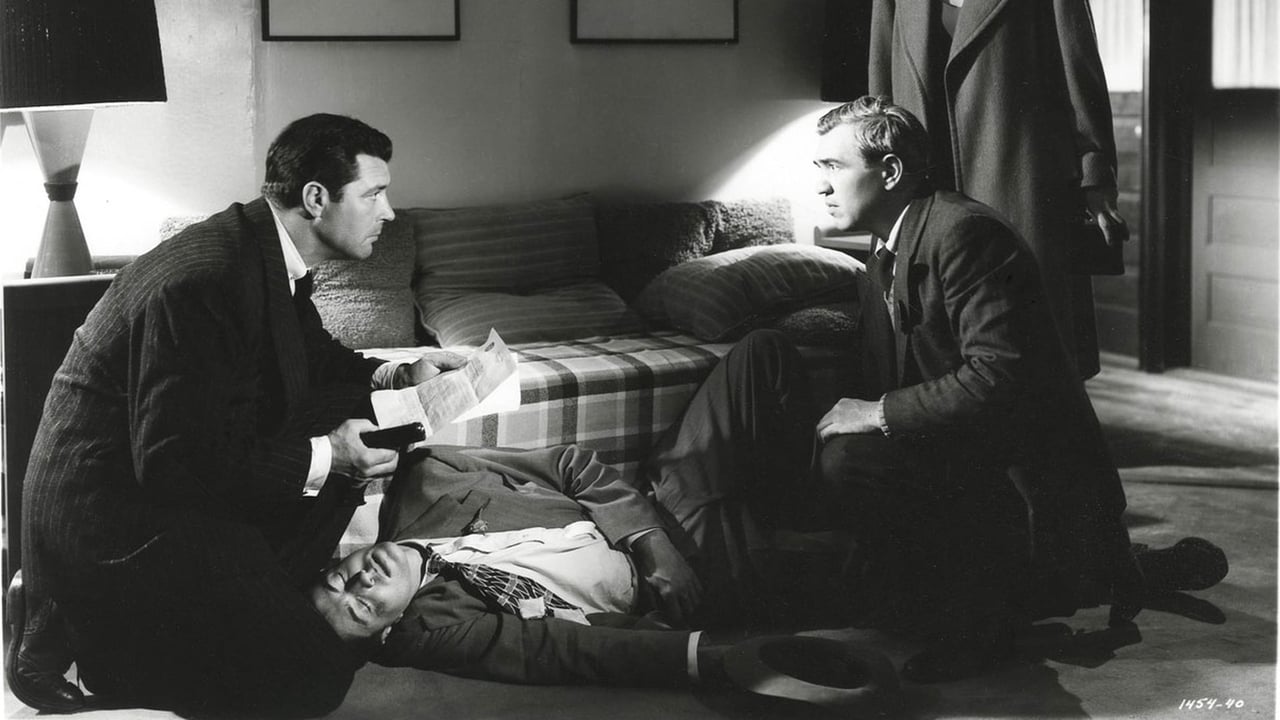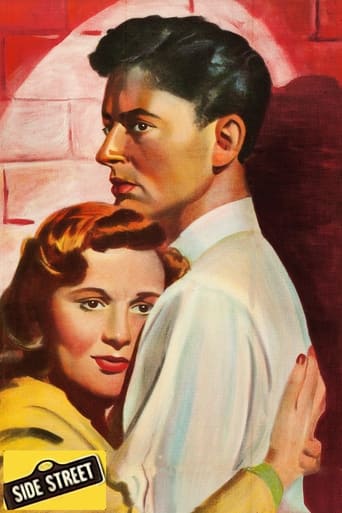Cleveronix
A different way of telling a story
Gurlyndrobb
While it doesn't offer any answers, it both thrills and makes you think.
Verity Robins
Great movie. Not sure what people expected but I found it highly entertaining.
Phillipa
Strong acting helps the film overcome an uncertain premise and create characters that hold our attention absolutely.
Spikeopath
Side Street is directed by Anthony Mann and written by Sydney Boehm. It stars Farley Granger, Cathy O'Donnell, James Craig, Jean Hagen, Paul Kelly, Paul Harvey, Edmon Ryan and Charles McGraw. Music is by Lennie Hayton (original) and Cole Porter (non original), and cinematography is by Joseph Ruttenberg.Joe Norson (Granger) is desperate for a full time job so he can support his pregnant wife Ellen (O'Donnell). Ever since he lost the filling station he invested in, Joe has struggled to get on top of things. Working part time as a mail carrier, Joe is tempted to steal what he thinks is $200 dollars from a lawyers office he delivered to earlier on his rounds. However, when he gets time to examine his plunder he finds there is in fact $30,000. This is merely the start of his problems, for the money is crooked and sure to be sorely missed by some very tough people. As he frets on how to get out of this mess, the police and the bad guys begin to draw ever closer.After the winning chemistry that arose out of Granger and O'Donnell's previous pairing for They Live By Night in 1948 (Nicholas Ray), it was no surprise to see them team up again for another slice of noirish pie. With Anthony Mann in the directing chair, having already established himself with the likes of T-Men and Raw Deal, and a decent budget in place, Side Street was in good hands. While although master cinematographer John Alton wasn't available, 4 time Oscar winner Joseph Ruttenberg was no small fry himself. Shooting in and around real New York locations, Mann and Ruttenberg give the film a real sense of authenticity, yes the plot takes some stretching of the imagination, but visually the picture is most appealing to the film noir fan. Be it aerial shots of the maze like Lower Manhattan setting or the shadowy flecked interiors that cloak the characters, Side Street showcases some strengths of director and photographer alike.Certainly inferior to They Live By Night, and only mid tier of the noir pictures helmed by Mann, Side Street none the less still functions real well as a taut story that features a classic noir protagonist seemingly doomed by his actions. Even though Joe Norson is wimpy, idiotic even, the narrative spins him into a sequence of events that make for some riveting sweaty panic, and sweaty panic is something that Granger does considerably well here. There's no great fleshing out of the romance between husband and wife, because Joe is on the run around mostly, so O'Donnell is more of a secondary character, but we do feel the love and this helps considerably for the last quarter of the film.It does at times feel like a hammer is tapping us on the forehead with its "Crime Doesn't Pay" morality, however, the bursts of violence bite hard and with Mann adroit in his action construction (a high speed car pursuit in the finale is top draw), film manages to rise above its flaws to entertain fully. In support it's Kelly (narrating and head investigative copper), Ryan (cagey lawyer) and Hagen (torch singer who likes a drink) who leave the best marks, while McGraw, arguably miscast as a good guy, is still good value for a gruff voiced presence. It does feel like an illegitimate second cousin to The Naked City, and a touch more claustrophobia wouldn't have gone amiss on the atmospheric front, but Side Street is a comfortable recommendation to the crime/film noir fan. 7/10
jzappa
MGM trusted they could reproduce the sensation Farley Granger and Cathy O'Donnell had while starring in Nicholas Ray's They Live by Night, but they just couldn't generate the same romantic fire with this script to make it feel more palpable. In old movies, people too often seem to plan to change their minds, plan to have a new feeling, plan to undergo a change of heart, react, realize, when in reality they're utterly unconscious, spontaneous, organic things, especially in life-or-death situations involving surviving the mob. The acting feels forced at times, demonstrating transitions rather than creating, or allowing them. It's not a plaguing, or by any means unique, flaw, and there are moments of effective acting and writing, but Side Street succeeds primarily for its action sequences. And while it's not the dramatically engaging story that Ray's film was, Anthony Mann's results in a photographically engaging film noir thriller shot in New York City.Mann was recognized for his scenes of violence, and using antagonistic surroundings to dramatic effect. He structures his narrative as a ride, in which each juncture is discerned by new backdrops, the scenery growing more and more unwelcoming as the film goes on, figurative of the hero's fall into disarray. The earliest shots of the hero are blended in with the opening montage. He looks into a shop window, where the reflection also contains numerous massive buildings. This is a perspective shot down the street, and the hero emerges from the middle of the shot, to a close-up at front. He is one of a cluster looking at a worker digging up a street. Huge buildings make oblique, occasionally trapezoidal panes in the background. Throughout the film, shots illustrate cityscapes, outlined and shrouded by the convex reflections in windows of taxi cabs and ambulance doors.The film opens with a succinct homage to the New York police, and one expects that one is going to see a semi-documentary about the police. In spite of this, while the police are ongoing characters in the film, the semi-doc conventions are minimized. There are no lab scenes, and not much effort is made to lionize the cops. Usually in movies like this of the era, the police consume lots of time tracking down and interviewing people in the victim's address book and consult them at work. Neighborhood kids tell where missing men can be found. More successful than any other method is following the money trail. Here the hero does this, rather than the police, tracking down the money wrappers to the bank.A major cop character is played by Charles McGraw. The film has a great comic shot where this super tough officer has to hold a coddled Pekinese dog found at a crime scene. This incongruity is charming. McGraw shows himself a good sport here. There are other dynamics at play than mere humor, though. The fact that this gruff man is nice to dogs hints at a primarily wholesome feature to his character. A man who is gentle to dogs is indicative that he'll be gentle to children, and care for them. This is a significant illustration, in a film that depends on its green hero Farley Granger's effort to mature, and be a dependable family man himself.Nothing like the youthful, blue-collar star, the villain appears to be well-to-do, while obviously too much of a street thug to be authentically posh. He is dressed in one of the flashiest pinstriped suits of the whole film noir period. He unquestionably looks the class of commercial triumph that Granger wants to be but isn't. The villain's social rank fluctuates in a dreamlike manner throughout. Initially he seems like the personification of prosperity and influence, seen in a chic business suit in a lawyer's office. As the film goes on, this pretense of a flush entrepreneur is stripped away. And the tension builds on a purely gut level, which is sometimes enough.
kenjha
Granger and O'Donnell, who co-starred in "They Live by Night" a couple of years earlier, are reunited in this taut film noir about a decent fellow who gives in to temptation and has his life unravel. Mann, known mainly for Westerns, does a terrific job of capturing life on the tough, gritty streets of New York City. The story of an innocent man who gets deeper and deeper into trouble is reminiscent of Hitchcock. Granger, who would star in Hitchcock's "Stangers on a Train" the following year, is perfectly cast as everyman. All the characters, even the minor ones, are well played, including Kelly as the police captain and Hagen as a singer.
MARIO GAUCI
Superbly-handled noir, from one of its absolute masters; despite their reputation for wholesomeness, MGM were really into the groove during this time (one of the genre's finest and most influential offerings, John Huston's THE ASPHALT JUNGLE came from them the same year). Apart from reuniting the hounded young couple from Nicholas Ray's THEY LIVE BY NIGHT (1948), Farley Granger and Cathy O'Donnell, the film also follows the 'story of a city' format laid down by Jules Dassin's THE NAKED CITY (1948).The narrative (written by genre expert Sydney Boehm) may be implausible at face value, but the snowballing of events – with the perplexed Granger at their centre – carries a genuine social resonance (though, thankfully, straying from sentimentality for the most part) and an undeniable charge of excitement (particularly towards the end, when the bodies start piling up and the police are closing in). O'Donnell's role doesn't allow her much range – though her instinctive appeal in the presence of the police for Granger to run away (with the camera suddenly zooming-in to her face) is beautifully done. Paul Kelly is the compassionate police captain on the case who also narrates the tale; one of his assistants is noir regular Charles McGraw.The rogues' gallery includes the thuggish James Craig (it was surprising to find the hero of THE DEVIL AND DANIEL WEBSTER [1941] on the opposite side of the tracks), a corrupt lawyer, another lackey who conveniently uses his cab for kidnapping/body-disposal purposes and, of course, a couple of dames (Jean Hagen is a particular stand-out here: she was also in THE ASPHALT JUNGLE, as a good girl this time). As I said, the climactic car chase along New York streets (shot on location) is terrific – though the ensuing happy ending feels tagged-on (MGM may have ultimately vetoed a downbeat finale) - if still leading to a memorable final shot.

